AMERICAN AUDIO VMS5

SETUP
Drivers: Install the latest ASIO drivers (for Windows only) from http://www.adj.com/vms5
No drivers is necessary to install on a Mac OSX computer.
Setup: Set the front switcher to 8out position. Connect your amplified speakers or your amplifier to the Master (RCA or XLR) outputs at the rear side and power on the unit from the back switcher. Connect your Headphones at the front side and make sure all MIDILOGS switchers at the front are on USB position.
VirtualDJ 8 Setup
If your VMS5 came bundled with a Limited Edition of VirtualDJ 8 , install VirtualDJ 8 from the provided CD, or download from http://www.virtualdj.com/le .
Once VirtualDJ 8 is launched, a Login Window will appear. Login with your virtualdj.com account.
A Pro Infinity a PLUS Controller, a Subscriber License or a LE keycode is required to use the American Audio VMS5. Without any of the above Licenses, the controller will operate for 10 minutes each time you restart VirtualDJ.
http://www.virtualdj.com/buy/index.html

If the LE version (or the customized skin) is installed an additional change skin button will be available to load the tailored VMS5 skin instead of the default one.
The tailored skin is installed along with the VirtualDJ LE, but can be downloaded from http://www.virtualdj.com/plugins/index.html?addonid=80602 as well.
Click OK.
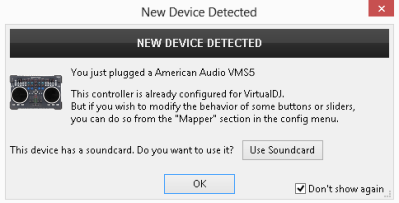
The unit is now ready to operate.
Advanced Setup
The unit should be visible in the CONTROLLERS tab of Settings and the factory default mapping should be offered in the Mappings drop-down list
The functions of the default mapping are described in this Manual, however those can be adjusted to your needs via VDJ Script actions.
Find more details at
http://www.virtualdj.com/wiki/VDJ8script.html

The unit has a pre-defined Audio setup and a special button in the AUDIO tab of Settings to provide that. Alternative Audio setups can be applied in the same window (see Advanced Audio Setup).
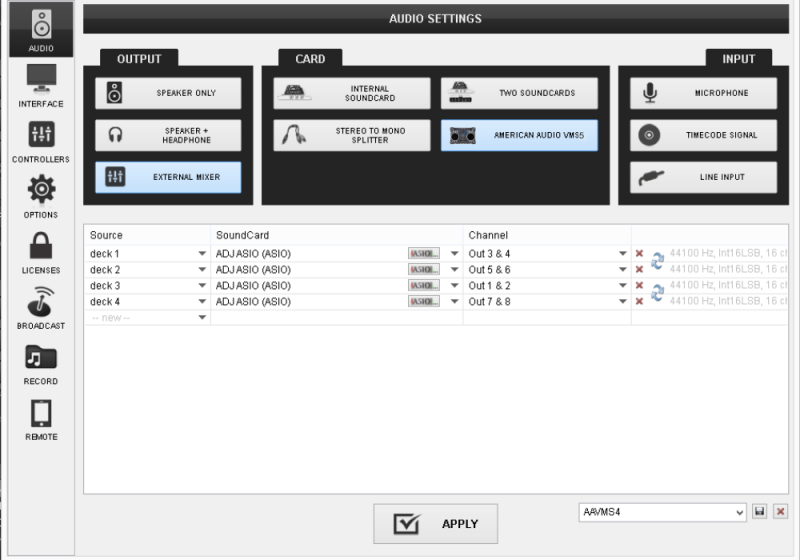
Please refer also refer to the technical features of the unit for further connections/capabilities and setups.
http://www.adj.com/vms5
For further VirtualDJ settings and features please refer to the User Guide of VirtualDJ 8.
http://www.virtualdj.com/manuals/virtualdj8/index.html
MIXER
The mixer of the VMS5 is routing and handling the sound internally (hardware), but all the adjustments and movements are visible on the VirtualDJ GUI.

- CROSSFADER. Blends audio between the channels assigned to the left and right side of the crossfader.
- VOLUME. Use the Volume faders to adjust the Volume of each Midilog/Deck.
The VU meter LEDs indicate the level of the Master Output. If a CUE/PFL button is selected, the VU METERS will indicate the level of the selected Midilog/deck. - CUE/PFL. Press these buttons to send one or more Midilogs/decks to the Headphones Output channel.
- EQ (BASS/MID/TREBLE). Adjust the Low/Mid/High frequencies for each Midilog/deck. See more in EQ Mode.
- GAIN. Adjust the Gain of each Midilog/deck
- MASTER VOLUME. Adjust the level of the Master Output.
- BALANCE. Balance the Master Output (Left I Right Pan)
- BOOTH VOLUME. Adjust the level of the Booth Output.
DECKS
S. SHIFT. Press and hold this button down and then use other buttons and knobs of the VMS5 to access secondary functions (described in this manual)

- DECK SWAP (A/C, B/D). Press this button to swap the assigned decks for the left or right side of the VMS5. The left side of the VMS5 can be assigned to control decks 1 or 3 and the right side can be assigned to control decks 2 and 4.
- PLAY. Use this button to play/pause the track.
- CUE. When track is paused, use this button to set a temporary Cue Point at the current track’s position. During playback, you can press the Cue Button to return the track to this Cue Point. (If you did not set a Cue Point, then it will return to the beginning of the track.).
If the Deck is paused, you can press and hold the Cue Button to play the track from the Temporary Cue Point. Releasing the Cue Button will return the track to the temporary Cue Point and pause it.
To continue playback without returning to the Temporary Cue Point, press and hold the Cue Button, then press and hold the Play Button, and then release both buttons. - JOG. Touch-sensitive jogwheel for scratching (Vinyl Mode), pitch bending (CD mode) and other functions described in this manual. If the jogwheel is on Scratch (Vinyl) mode, use the outer ring of the jogwheel to pitch-bend. Hold SHIFT down and then use the jogwheel to fast search through the loaded track (Seek mode)
- PITCHBEND -/+. Press and keep these buttons down to temporary slow-down/speed-up the tempo of the track. When the button is released, the track will return to the tempo defined by the pitch slider.
Hold SHIFT down and then use the same button to slow-down the track more intensively - PITCH. Adjust the track's playback speed (tempo).
The actual pitch fader will not alter the pitch of the track if the actual pitch and the software pitch value do not match (software soft-takeover- ghost fader visible on the GUI). In most cases this may happen if SYNC is prior pressed or switching decks and the other deck is having a different pitch software value. - SYNC. Press this button to automatically match the corresponding Deck's tempo with the opposite Deck's (or the Master Deck’s if using a 4 decks Skin) tempo and phase.
Hold SHIFT down and then tap this button (at least 4 times) to manual adjust the tempo of the track. When track is paused, press this button once, to set a Beatgrid anchor at the current position. - LOCK. Press this button to "lock" the track's pitch to its original key. (Master Tempo). The track's tempo will remain at the speed designated by the Pitch Fader.
Hold SHIFT down and then press this button to adjust the range of the Pitch Fader ( to ±6%, ±8%, ±10%, ±12%, ±20%, ±25%, ±33%, ±50%, and ±100%). - VINYL. Press this button to set the Jogwheel to Vinyl (Scratch) or CD (Bend) mode. In Vinyl mode, use the outer part of the Jogwheel to bend (temporary speed up – slow down the tempo of the track).
Hold SHIFT down and then press this button to enable/disable Slip mode. When Slip mode is enabled, several actions (such as HotCues, Loops and Scratch) will act temporary and the track will resume to the position it would have been if this action was never triggered. - SEARCH<</>>. Press and hold these buttons to move the track backwards/forward by 4 beats.
Hold SHIFT down and then use these buttons to move the track backwards/forward by 8 beats (faster seek)
NAVIGATION
 The Navigation system (4 Navigation buttons and the Navigation Encoder) offers Browser, Video Transition, Video Effect and Sampler functions.
The Navigation system (4 Navigation buttons and the Navigation Encoder) offers Browser, Video Transition, Video Effect and Sampler functions.There are 4 Modes for the Navigation system and those are selected holding SHIFT and pressing one of the 4 Navigation buttons.
- Default (Browser) mode:
Hold SHIFT down and press the UP Navigation button (9) to set the Navigation system to Browser mode. This mode is by default pre-selected when VirtualDJ is launched. - UP. Use this button to set focus to the Folders List of the Browser. If focus is on the Folders list, use this button to expand/collapse sub-folders.
- LEFT. Use this button to load the selected track to the left assigned deck. Hold the same button for more than 2 seconds to unload the same deck.
- RIGHT. Use this button to load the selected track to the right assigned deck. Hold the same button for more than 2 seconds to unload the same deck.
- DOWN. Use this button to set focus to the Sideview. If focus is on the Sideview, use this button to cycle through the available Sideview panels (Automix, Sidelist, Karaoke, Sampler and Shortcuts).
Hold this button down for more than 2 seconds to show/hide the Sideview panel.
Note that in LE mode, the Sideview is only offering the Trigger Pad view of the Sampler. - ENCODER. Use this encoder to scroll through files or folders depending on the focused list. Push the Encoder to set focus to the Songs List.
Hold SHIFT and then use the Encoder to cycle through the available center panels of the Skin (Mixer, Video, Scratch and Master). Hold SHIFT down and then push the Encoder to cycle through normal and zoomed Browser mode. The zoomed mode is only offered in the tailored VMS5 skin).
- Sampler mode:
Hold SHIFT down and press the DOWN Navigation button (12) to set the Navigation system to Sampler mode. - UP. Use this button to select the previous available Sampler trigger mode (On/Off, Hold, Stutter and Unmute)
- LEFT. Use this button to load the previous available Sampler Bank.
- RIGHT. Use this button to load the next available Sampler Bank
- DOWN. Use this button to select the next available Sampler trigger mode (On/Off, Hold, Stutter and Unmute)
- ENCODER. Use this encoder to adjust the Master Output Volume of the Sampler. Push the Encoder to open/close the Sampler panel of Sideview.
Hold SHIFT and then use the Encoder to adjust the Loop of the triggered Sample (applies to Samples set in Loop mode). Hold SHIFT down and then push the Encoder to set the selected Sample in Loop (or Flat) mode.
- Video Transition mode:
Hold SHIFT down and press the LEFT Navigation button (10) to set the Navigation system to Video Transition mode. - UP. Use this button to select the previous available Video Transition
- LEFT. Use this button to trigger the selected Video Transition.
- RIGHT. Use this button to open/close the GUI of the selected Video Transition at the right side of the Browser and view additional controls and info (if available)
- DOWN. Use this button to select the next available Video Transition
- ENCODER. Use this encoder to adjust the 1st or 2nd Parameter of the selected Video Transition (if available). Push the Encoder to select the 1st or the 2nd Parameter of the selected Video Transition to be controlled by the Encoder.
Hold SHIFT and then use the Encoder to cycle through the available center panels of the Skin (Mixer, Video, Scratch and Master). Hold SHIFT down and then push the Encoder to cycle through normal and zoomed Browser mode. The zoomed mode is only offered in the tailored VMS5 skin).
- Video Effect mode:
Hold SHIFT down and press the RIGHT Navigation button (11) to set the Navigation system to Video Effect mode. - UP. Use this button to select the previous available Video Effect
- LEFT. Use this button to trigger the selected Video Effect.
- RIGHT. Use this button to open/close the GUI of the selected Video Effect at the right side of the Browser and view additional controls and info (if available)
- DOWN. Use this button to select the next available Video Effect
- ENCODER. Use this encoder to adjust the 1st or 2nd Parameter of the selected Video Effect (if available). Push the Encoder to select the 1st or the 2nd Parameter of the selected Video Effect to be controlled by the Encoder.
Hold SHIFT and then use the Encoder to cycle through the available center panels of the Skin (Mixer, Video, Scratch and Master). Hold SHIFT down and then push the Encoder to cycle through normal and zoomed Browser mode. The zoomed mode is only offered in the tailored VMS5 skin).
EFFECTS & LOOPS

- FX SELECT. Use this encoder to select the Effect applied to the Left or Right selected decks.
Push the encoder to get the Effects list for easier navigation through the list. Push again to select and close the List.
Hold SHIFT down and then use this encoder to adjust the Key of the loaded track. - FX.PARAM. Use this knob to adjust the 1st Parameter of the selected Effect.
If the CTRL button (27) is enabled, use this knob to control the 2nd Parameter of the selected Effect. - FX ON. Use this button to trigger the selected Effect to the Left or Right selected deck. Hold SHIFT down and then press this button to reset the Key of the track to its original value.
- FX CTRL. Use this button to toggle the Effect Parameter Control. When enabled, the FX PARAM knob (25) will control the 2nd Parameter of the selected Effect and when disabled the 1st one.
- LOOP SIZE. Use this encoder to adjust the size of the Loop in beats. When moved anti-clockwise the size of the Loop will be halved and will be doubled when moved clockwise.
Hold SHIFT down and then use this encoder to move the Loop backwards/forward by a step equal to its size in beats.
Push the encoder to trigger an Auto Loop of the selected size in beats. - FILTER. Use this knob to apply a High/Low Pass Filter to the selected left or right deck.
- LOOP. Use this button to set and trigger a Manual Loop. While the track is playing, on first press, the button sets a Loop In (Entry Point). On 2nd press the same button sets a Loop Out (Exit Point) and triggers the Manual Loop. Press the same button again (3rd press) to exit the manual loop.
Hold SHIFT down and then press this button to trigger the last triggered loop (Re-loop). - FILTER ON. Use this button to activate/de-activate the High/Low Pass Filter. When disabled, the Filter will not be applied regardless the position of the FILTER knob (29).
MULTI-BUTTONS
The 4 HOTCUES/SAMPLES multi-buttons (33) offer different functionality depending on the selected mode.

There are 4 different modes selected by the CUES and SAM mode buttons (32)
- HotCues mode (default):
This mode is selected by default when VirtualDJ launches. In case a different mode is selected, press the CUES button to set the multi-buttons to HotCues mode (LED will light up red).
In this mode, the 4 multi-buttons assign a Hot Cue Point (1 to 4) or return the track to that Hot Cue Point. When a Hot Cue Button is unlit, you can assign a Hot Cue Point by pressing it at the desired point in your track. Once it is assigned, the Hot Cue Button will light. To return to that Hot Cue Point, simply press it.
Press and hold SHIFT and then press a Hot Cue Button to delete its assigned Hot Cue Point. - Loop Rolls mode:
Hold SHIFT and then press the CUES button to set the multi-buttons to Loop Rolls mode (LED will light up purple).
In this mode, the 4 multi-buttons trigger a Loop Roll of a different size in beats (1/8, 1/4, 1/2 and 1 beat) - Sampler 1-4 mode:
Press the SAM button to set the multi-buttons to Sampler 1-4 mode (LED will light up blue).
In this mode, the 4 multi-buttons trigger a Sample (1-4) of the selected Sampler Bank.
Hold SHIFT down and then use the same multi-buttons to stop the triggered sample (useful if the Stutter or Unmute trigger pad mode is selected)
If the Sampler 1-4 mode is selected, hold this button down and then use the 4 multi-buttons to select Sampler Bank 1 to 4. More Sampler Banks can be selected via the Navigation System (D). - Sampler 5-8 mode:
Hold SHIFT and then press the SAM button to set the multi-buttons to Sampler 5-8 mode (LED will light up purple).
In this mode, the 4 multi-buttons trigger a Sample (5-8) of the selected Sampler Bank.
Hold SHIFT down and then use the same multi-buttons to stop the triggered sample (useful if the Stutter or Unmute trigger pad mode is selected)
If the Sampler 5-8 mode is selected, hold this button down and then use the 4 multi-buttons to select Sampler Bank 1 to 4. More Sampler Banks can be selected via the Navigation System (D).
Note: In both Sampler modes, if the selected Sampler Bank has more than 8 samples, the left multi-buttons will trigger Samples 1-8 and the right side will trigger Samples 9-16. If the selected Sampler Bank has less than 9 samples, both sides of the VMS5 will control the same samples 1-8.
- SMART LOOP. Use this knob to enable/disable Smart (Auto) Loop mode. If this mode is enabled (default mode), a seamless loop will be triggered when a Manual Loop is applied (the size of the Manual Loop will be auto-adjusted).
FRONT paNEL

- MIC ON. Turn On/Off the Microphone Inputs 1 and 2 of the unit.
- MIC GAIN. Adjust the Volume of the Microphone Inputs 1 and 2 of the VMS5 (rear connection)
- MIC EQ. Adjust the Low (Bass), Medium (Middle) and the High (Treble) frequencies of the Microphone Inputs 1 and 2 of the VMS5.
- MIDILOG SWITCHER. Turn the switcher to the USB position to allow the Midilog Channel to control the VirtualDJ deck. In 4out mode, the Midilogs 1 and 4 will not route the sound to any VirtualDJ deck.
Turn the switcher to ANALOGUE position to use a Midilog as an analogue input source. In this position the sound of the VirtualDJ deck will be muted. - CROSSFADER CH ASSIGN. Define which Midilog will be assigned as left or right side of the crossfader. In OFF position all Midilogs/decks will be outputted on either left or right side of the crossfader. In all other positions, one Midilog will be assigned as left or right. Note that the numbers on the knob indicate the Midilogs and not the VirtualDJ decks. E.g. if the left CF CH ASSIGN knob is at the position numbered 2, (indicating the 2nd Midilog) VirtualDJ deck 1 will be assigned as left side of the crossfader.
- 4out-8out. Define the mode that the built-in sound card of the VMS5 will operate. See more in Advanced Settings.
- NORMAL-REVERSE. Switch to REVERSE position if you wish the crossfader to operate in reverse mode (Hamster)
- CROSSFADER CURVE. Define how the crossfader will blend left and right assigned channels (from Smooth to Scratch curve).
- CUE MIX. Adjust how the mixer Channels and the Master Output blend at the Headphones Channel. Hardware operation, but movement visible on the VirtualDJ GUI.
- CUE GAIN. Adjust the Volume Output of the Headphones Channel. Hardware operation, but movement visible on the GUI.
- HEADPHONES. Connect your Headphones
REAR PANEL

- POWER: Use the included power adaptor to connect VMS5 to a power outlet. While the power is switched off, plug the cable into VMS5 first, and then plug the cable into a power outlet. Use the Power Switch to turn the VMS5 on and off. Turn on VMS5 after all input devices have been connected and before you turn on amplifiers. Turn off amplifiers before you turn off VMS5.
The power connection is not necessary if the unit is only used as a Midi controller; however it is strongly advised to be used. - USB. This USB connection sends and receives audio and control information from a connected computer.
- MASTER OUTPUT (XLR): Connect this low-impedance XLR output to a PA system or powered monitors. The level of this output is controlled with the Master knob on the top panel.
- BOOTH OUTPUT (BALANCED): Use standard RCA cables to connect this output to a booth monitoring system. The level of this output is controlled by the Booth knob on the top panel.
- MASTER OUTPUT (RCA): Use standard RCA cables to connect this output to a speaker or amplifier system. The level of this output is controlled by the Master knob on the top panel.
- LINE INPUTS. Connect your audio sources to these inputs. Midilog Inputs 2 and 3 can accept both line and phono-level signals.
- MIC INPUTS. Connect your 1/4" or XLR microphones to these inputs. Microphone controls are located at the left-front Microphone panel.
Advanced Setup
4out mode & Audio Setup
The VMS5 offers a pre-defined audio configuration for the 8out mode, however if the 4out mode is selected from the front switcher (mainly for Timecode use), the audio needs to be manually configured as the Midilogs are not automatically assigned properly.
How to:
Go to the AUDIO tab of Config and change the decks order at the Source column as per the following images:
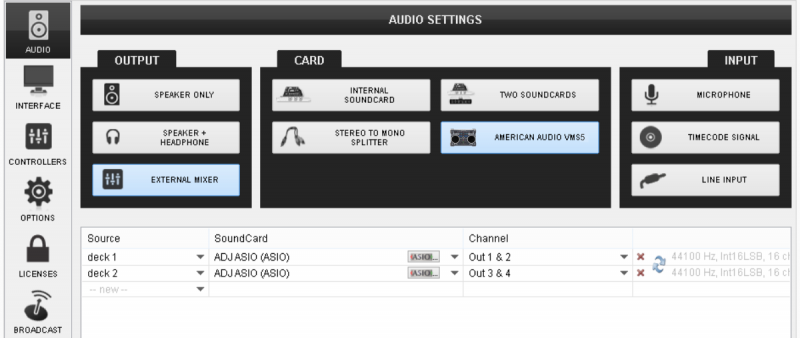
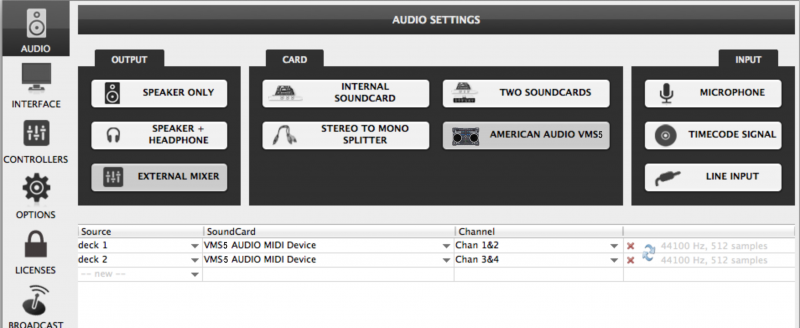
MORE...
In the next Chapters will be explained how to properly assign Midilogs to software decks (routing), change the EQ mode, how to record/broadcast your mix and how to setup and use Timecode system (DVS)
Midilog Routing & Mixer Order
The selection can be made with the default 4 decks skin of VirtualDJ 8 from the Mixer Options menu.
The mixer channel order 1-3-4-2 is not supported by the default mapping files and should be not selected.
Note also that the Fake mixer option is selected (cannot be changed from the menu). This option indicates that the audio mixing is handled by the VMS5 mixer and the VirtualDJ GUI will simply show the status of the VMS5 mixer but will not use the internal software mixer.
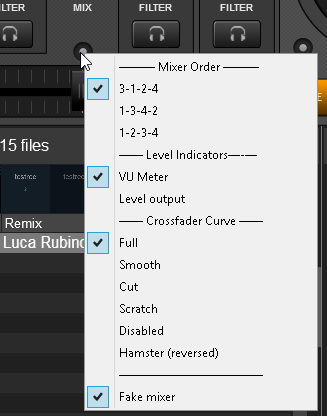
Depending on the selected channel mixer order, you will also need to properly assign the Midilogs channels, otherwise the GUI of VirtualDJ will show the correct mixer status but the audio will be routed incorrectly.
How to:
Go to the AUDIO tab of Config and change the Outputs order at the Channel column as per the images below
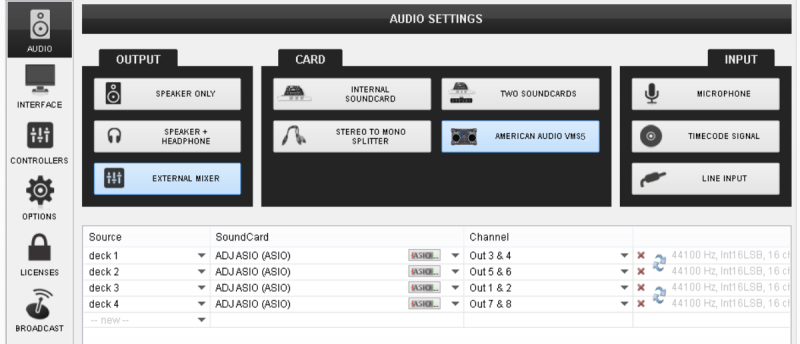


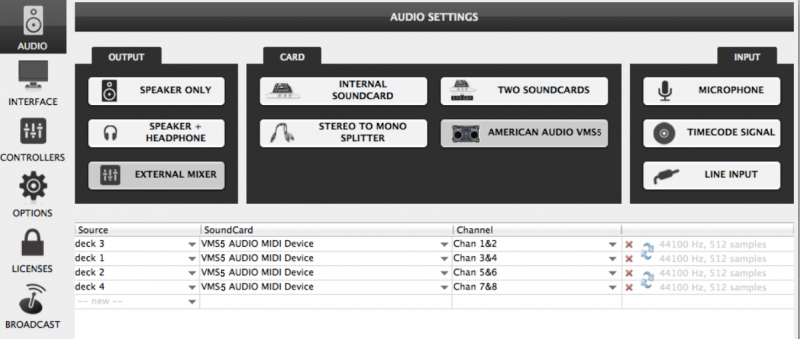
Midilog Routing using the ASIO settings (Windows only)
An alternative (but not suggested) way to assign the Midilogs to a different Output channel (instead of editing the Audio configuration of VirtualDJ as above) is within the ASIO Settings utility of the VMS5.
The default Midilog Channel assignment is the following.
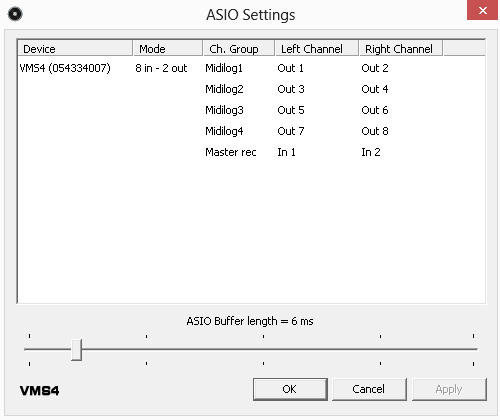
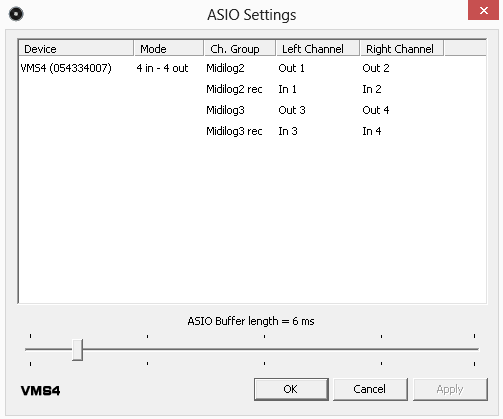
The Midilog routing on Mac OSX computers is only available within the Audio configuration of VirtualDJ.
EQ mode
The Equalizer (Treble, Mid & Bass) section of the VMS5 can work in two different modes, Pre EQ and Post EQ and those are offered in both 4out and 8out modes.
How to:
To toggle between the 2 EQ modes, before powering up the VMS5, press and hold the PFL CUE (4) on the 4th MIDILOG channel and then power "ON" the unit. Release the button. Your computer may reinstall the VMS5 as a new device, please allow 10-20 seconds for the change to take place.
You can verify the change from the ASIO Settings Utility (Windows only)
In Pre EQ the USB audio signal is affected by the VMS5 EQ. Pre EQ is the default EQ. In
Pre EQ mode the ASIO Driver will list the VMS5 device number, the first number in the sequence will be a "0" (see image below)

Post EQ is for users who prefer using the EQ from VirtualDJ instead of the Hardware one (e.g. to get the parametric EQ of VirtualDJ 8).
In Post EQ mode the ASIO Driver will list the VMS5 device number, the first number in the sequence will be a "1" (see image below)
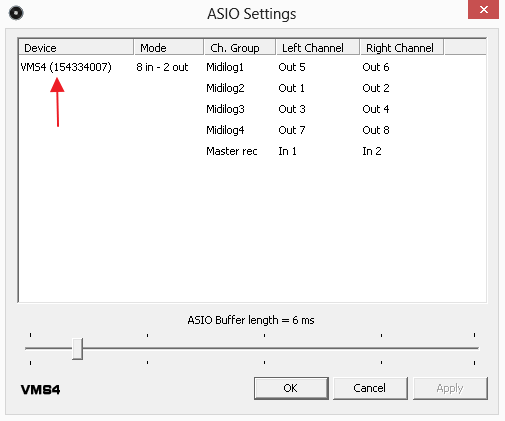
If the Post EQ mode is selected, you will also need to modify the ONINIT key of the Mapping files (or at least the one that you need to use – Default or Browser mode).
How to:
Launch VirtualDJ 8 and head to the CONTROLLERS tab of Config. Select the American Audio VMS5 from the left devices list and select the mapping file you wish to use (and modify). Locate the ONINIT key from the middle Key list (you can also sort by Key for easier search).
Click on the ONINIT key to get the pre-assigned action in the Action field.
Edit the fake_eq on action to fake_eq off

Once the change is done, a modified (custom) mapping will be auto-created which can be renamed as well from the top-right field.
Re-launch VirtualDJ 8 or choose a different mapping and back the one you edited again, in order the assigned action of the ONINIT key to be applied.
To verify that the “fake” EQ is off and the VMS5 is now controlling the VirtualDJ Internal EQ (for both Windows and Mac), the EQ knobs should not now kill the sound if all 3 EQ Band knobs are at the far left position and the EqualizerMode setting is set to Default from the OPTIONS.
Recording & Broadcasting
VirtualDJ will not be able to record (or broadcast) your mixing directly as the audio mixing is handled by the VMS5. In case you need to record (or broadcast) your mixing along with all the external sources (AUX) and the Microphone Inputs of the VMS5, you will need to manually add a record line to the Audio configuration as following.
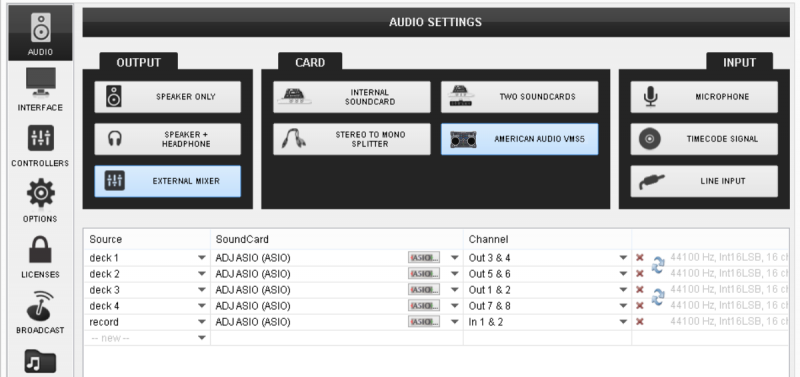
Note that the VMS5 needs to be on the 8out mode for proper recording.
Timecodes
The VMS5 is capable to offer a Timecode setup (DVS) with its built-in 4out/4in audio interface.
How to:
Power off the unit, set the front switcher to the 4out position and power the unit back on.
Launch VirtualDJ 8, head to the AUDIO tab of Settings and click on the TIMECODE SIGNAL button you will find at the INPUTS tab of the Audio Settings.
2 additional lines will be automatically added to the audio configuration. You will then need to make sure that the decks are routed properly to the Midilog Channels as per the following image or as per the images shown in the 4out mode.

